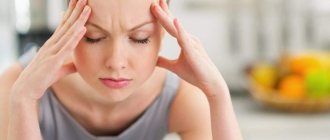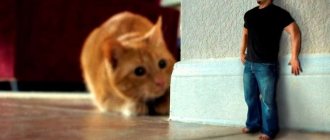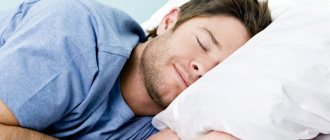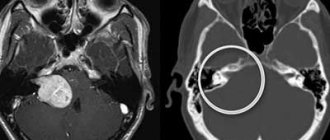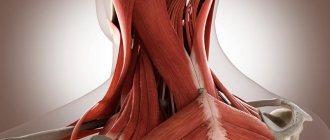Pain in the lumbar region is a fairly common occurrence. It can be caused by quite a variety of conditions. Pain in the lumbar region is recorded in the following pathologies:
- vertebrogenic and discogenic lesions of nerve roots;
- renal colic;
- pancreatic diseases;
- pathological changes in vertebral bone tissue.
The symptoms described by various authors, indicating pathology of the spinal disc segment, help to establish the cause of the pain syndrome, diagnose damage to the nerve roots and clarify the severity of the disease.
The most frequently studied phenomenon, which has diagnostic significance and also plays a role in determining the patient’s ability to work, is Lasegue’s symptom.
General information
Lasegue's symptom from the group of violations of the tension of the roots is also called “pathology of straight leg raising” and is characteristic of neuropathy of the femoral nerve and spinal roots, Guillain-Barr syndrome , etc.
The symptom is named after the French physician Ernest Charles Lasegue, famous for lecturing on the mentally ill in Paris in the 19th century. Being a representative of traditional medicine, he preferred the observational technique of treating patients over the experimental one. The symptom he discovered plays a very important diagnostic role in neurology.
Diagram of the connection between the sciatic nerve and the spinal cord
Method for identifying Lasegue's symptom
During the examination, the doctor places the patient on his back on the couch and begins to smoothly lift the subject's leg, bending it at the hip joint and holding the knee. The leg is raised to a maximum of 90° or until pain occurs along the sciatic nerve. At this stage, it is important that the patient clearly determines at what angle the pain occurs. The true Lasegue symptom in neurology is an important indicator for tracking the dynamics of the disease.
At the next stage, the medical worker must bend the leg at the knee and if the pain stops, then Lasegue’s symptom is considered positive; when returning to the starting position - straightening the leg, the pain should resume. Otherwise - if the acute pain has not stopped, then the origin of the pain is different - it is not caused by the tension of the affected spinal root.
Interpretation of results
A positive test can be recognized if the patient experiences acute persistent pain in the hip area when raising the leg to 60 degrees and pain relief when bending the knee. Such symptoms indicate damage to the sciatic nerve.
In older patients, the test is considered false positive if pain is associated with decreased muscle activity. The test is considered negative if the person does not experience pain when bending the limb at the knee.
There is also a cross Lasegue symptom. It is diagnosed if the patient, when lifting his healthy leg, experiences pain on the side of the hip of the diseased limb.
Pathogenesis
The so-called “position” and “tension” symptoms are based on myofixation of the affected movable segment - reflexive or subconscious, which occurs as a result of irritation of the receptors present in the deformed tissues. This may increase intradiscal pressure. Normally, nerves have a reserve of length, although limited. They are able to move in relation to nearby tissues in the fascial bed, so there is almost no tension on the nerve. However, if for one reason or another pathological changes develop in nearby structures - their fibrous growth, deformation - then this can lead to excessive overstretching of the nerve.
When lifting a leg in people, depending on the angle (usually 70-90°), pain occurs in the lumbosacral region and the back surface of the limb, more often in the area of the lower leg, popliteal fossa, thighs and buttocks, because they act in such a situation as one whole, while the lumbar lordosis is straightened, the iliopsoas muscles are activated, the remaining parts of the spine are brought closer together, which causes injury to the affected tissues or excessive tension of the sciatic nerve roots.
Treatment of lumbar osteochondrosis
A neurologist is responsible for diagnosing the patient and prescribing the necessary treatment procedures. If this destructive-degenerative process is accompanied by pain of increased intensity or disruptions in the functioning of any internal systems, the opinion of doctors of other specialties may be required.
To clearly understand how to treat lumbar osteochondrosis, it is enough to imagine the following scheme: performing diagnostic measures, clarifying the degree of progression of the pathology, identifying the consequences for the body. Taking into account the information obtained, the need for surgical or conservative procedures is determined.
Our medical center employs experienced neurologists and physiotherapists who can make an accurate conclusion about the presence of osteochondrosis, and also perform treatment procedures that allow you to obtain reliable and prolonged results.
Exercise therapy for lumbar osteochondrosis
The effectiveness of physical therapy for this disease is obvious. However, a set of exercises should be carried out by an experienced rehabilitation physician in a room with special equipment. A prerequisite for exercise therapy is the absence or weakening of pain in the patient after an illness. In addition, the specialist must monitor the patient’s condition during exercise. If any discomfort occurs, classes are stopped or adjusted.
Gymnastics for osteochondrosis of the lumbosacral spine is performed in several successive steps. During the warm-up period, exercises are performed to improve blood circulation and warm up muscle tissue. The basic part contains a complex for the area of the spine that has undergone destructive and degenerative changes. At the final stage, relaxation exercises are performed.
As part of therapeutic exercises for osteochondrosis of the lumbar spine, it is recommended to perform the following set of exercises:
- While in a vertical position, it is necessary to bend the entire body in all directions;
- Take a “lying” position and strain your abdominal muscles, pressing your spine to the floor surface;
- Place your hands behind your head and stretch up;
- Stand on both arms and both legs and move forward slightly, then return to the starting position. Do several repetitions.
Massage for osteochondrosis of the lumbar spine
For such problems with the spine, segmental, vacuum, connective tissue and acupuncture massage techniques can be performed. However, the best results can be achieved with a classic massage.
During the procedure, the specialist performs standard movements: kneading, rubbing, stroking, vibration. The main objective of this method is to relieve muscle spasms, normalize blood circulation in the damaged area, and strengthen the musculoskeletal system.
Physiotherapeutic procedures
The key goal of physiotherapy is to relieve pain, normalize blood flow, saturate cells with oxygen and reduce inflammation. In this case the following is carried out:
- Electrophoresis. Allows you to eliminate the neurological symptoms of the disease;
- Ultrasound exposure along the damaged area of the spinal column;
- Exposure to magnetic field;
- Diadynamic therapy. To relieve discomfort, currents of various frequencies are used.
To achieve maximum results, several physiotherapeutic methods are used simultaneously.
Shock wave therapy for lumbar osteochondrosis
The UVT technique is based on the action of acoustic pulses of different frequencies. Thanks to this method, it is possible to normalize metabolic processes in the body, trigger natural cell restoration, and speed up metabolism. To relieve pain, 1-2 procedures are enough.
After completing the full course, it is possible to restore the functionality of the intervertebral discs and regenerate their tissues.
If the procedure is performed properly, the patient can avoid the use of medications and surgery.
We provide shock wave therapy under the guidance of experienced physiotherapists, using innovative Swiss technology and in a comfortable environment. Moreover, when visiting the medical center for the first time, you can count on a 20% discount.
Drug treatment of osteochondrosis of the lumbar spine
It is possible to count on effective and prolonged treatment results with an integrated approach, namely, with the simultaneous use of medications and physiotherapeutic procedures.
As part of drug therapy, the following medications are recommended:
- Non-steroidal drugs (Ibuprofen, Diclofenac, Nise). Allows you to relieve inflammation and pain;
- Painkillers. They help eliminate painful manifestations that cannot be relieved using the means of the previous group;
- Drugs that reduce the tone of skeletal muscles (Sirdalud, Mydocalm,). Helps eliminate muscle spasms;
- Products that ensure the regeneration of cartilage tissue (Dona, Teraflex). Restore tissue of the spinal column;
- Vitamins (Pyridoxine, Thiamine). Restore immunity, improve conductivity of nerve cells;
- Agents that help normalize blood flow (Nicotinic acid, Pentoxifylline).
Surgery
Surgery is considered an emergency treatment for compression of the spinal roots by a hernia. During the intervention, the herniated disc is removed, and a procedure is also carried out to increase the lumen of the spinal canal and minimize compression on the nerve structures.
Frequently implemented methods of surgical intervention include: implantation, intervertebral disc removal procedure, nucleoplasty, stabilization of the spinal motion segment.
Traditional methods of treatment
Along with traditional methods of treatment, you can use traditional medicine recipes. These include:
- Compresses with mumiyo. Provides the possibility of tissue regeneration, eliminates inflammation. Before use, it is recommended to dissolve the mumiyo in water;
- Propolis. To obtain the desired effect, it is necessary to make a cake from plant materials. Then apply to the damaged area of the spine and leave for 24-48 hours until pain is completely relieved;
- Use of mustard plasters. Provide a warming effect, improve blood circulation, accelerate the flow of nutrients into tissues, eliminate discomfort and inflammatory processes;
- Kuznetsov applicator. The device has the form of a roller, belt or flat mat with spikes. Allows you to normalize blood flow and eliminate painful manifestations.
Classification
Depending on the severity of the manifestations, the positive Lasegue symptom is of 3 types:
- the first type - which is characterized by a mild manifestation of low-intensity pain that occurs when the patient raises his leg no higher than an angle of 60°, and a protective reaction occurs in the form of a moderate contraction of the muscles of the back and pelvis, as well as the abdominal wall;
- the second type is characterized by moderately severe pain when lifting the leg at an angle of no more than 45°, which causes a moderate autonomic reaction and protective contraction of individual muscle groups;
- the third type is manifested by pronounced pain when lifting the leg at an angle of up to 30° against the background of generalized protective muscle contractions and a sharp autonomic reaction; such a disorder is considered articular, since when lifting by so many degrees, tension on the root does not occur.
Determination of the leg elevation angle when testing for Lasegue's symptom
Important! Elderly people with weak hamstring muscles may experience a pseudo-positive Lasegue sign, which usually manifests itself as soreness in the thigh muscles.
Modification of Lasegue's symptom can be used for expert cases:
- to identify pain when lowering the leg on the edge of the couch in patients lying on their stomach;
- conducting a study of Lasegue's symptom in patients in a standing position;
- the use of Vengerov's maneuver, in which the abdominal muscles contract during the study of Lasegue's symptom, which requires additional preliminary distraction;
- study of the cross Lasegue symptom with ankylosing spondylitis, which causes pain in patients in the “sick” leg using the Lasegue method on the healthy side.
Lasègue tension symptom: application and evaluation of the syndrome in neurology
Sometimes it can be very difficult to make a correct diagnosis of a neurological disease. This is due to the fact that most patients are not able to objectively assess pain and exaggerate the extent of symptoms. With prolonged pain, a situation may arise in which a person is unable to correctly interpret the pain, and in rare cases, it may be completely ignored. An objective picture of neurological diseases of the spine can be identified using tension symptoms.
Causes
The cause of Lasegue's symptom quite often is damage to the nerves of the lumbosacral plexus, for example, as a result of lumbar osteochondrosis , hernia , hematoma , abscess , ankylosing spondylitis , radiculitis , neoplasms, piriformis syndrome , heavy fetus in late pregnancy. Such changes are very dangerous, as they can lead to pinched sciatic nerve , paralysis and disability.
Sciatica when raising the leg can also occur as a result of organic lesions of the sciatic nerve caused by diabetes mellitus , infections or intoxications .
What does the symptom reveal?
The patient lies on his back. The extended leg is passively bent by the doctor to 70°. If sharp, shooting or burning pain occurs in the leg at an angle of about 45 degrees, the test, as mentioned above, is considered positive. The pain is caused by stretching of the nerve. When pain is detected at an angle of 60-70°, it is referred to as a pseudo-positive Lasegue sign.
Severe leg or hip pain should be considered muscle pain. The symptom may be aggravated by simultaneous internal rotation of the leg. Also, by rotating the foot, you can intensify the symptom (the so-called Bragar symptom). You need to measure the angle at which discomfort begins. Pain usually leads to a reflexive return of the limb to its original position. The nerve roots of the L4/L5 or L5/S1 segments are compressed during this maneuver.
The test may be positive for sciatica, disc herniation, meningitis, or subarachnoid hemorrhage.
If a patient experiences joint pain when the sprained leg is at an angle between 30 and 70 degrees, it is likely that the cause of the pain is a herniated disc.
A recent meta-analysis examined the information content and found that the test has:
- 91% sensitivity;
- 26% specificity.
If raising the opposite leg causes pain:
- sensitivity 29%;
- specificity 88%.
The test is usually performed on people with back pain to differentiate lumbago from sciatica. The test is not 100 percent reliable, but it usually gives a good and quick score. The test in medicine helps assess damage to nerve fibers. However, only a neurologist can make an accurate diagnosis. The test does not replace instrumental diagnostic methods, as well as conversations with a specialist. It is recommended to perform the test for informational purposes at home, and not for diagnostic purposes.
The Lasègue symptom has two variants:
- The first is the occurrence of pain along a vertical limb during passive elevation.
- The second develops by bending the limb at the hip and knee joints, and then straightening it. Similarly, a positive symptom manifests itself in the occurrence of sudden pain along the limb.
The diagnostic test is as follows: the subject lies supine with the pelvis stabilized. The doctor performs a passive leg lift on the patient. If the pain occurs in a non-physiological range, this means that the doctor is dealing with a radicular syndrome and, more specifically, with pressure on the sciatic nerve. The pain is caused by stretching of the SC nerves. Spinal nerves enter the spinal cord on the right and left sides of the spine. In most cases, the examination is repeated on the other leg.
The test can also be painful for healthy people if they suddenly lift their legs. However, if the pain occurs at a low altitude, then the result is said to be positive, which in this case means that the test gave a painful result. For example, a positive symptom may indicate a herniated disc, changes in the vertebrae associated with normal aging, or meningitis.
Meningitis
Advice! If a sharp pain reaction or other unfavorable manifestations (symptoms) occur while lying down, you should immediately consult a doctor.
If you have shooting pain on the left or right in the lower back, you should also contact a doctor after the experiment to clarify the cause. Self-treatment is not recommended. The test is not a final diagnosis, so the results should not be taken seriously. False-positive results are very common, so it is important to always confirm the diagnosis and symptoms with your doctor. Incorrect treatment can lead to irreversible and serious consequences, as can incorrect self-diagnosis.
Diet for Lasegue's symptom
Rejuvenating diet against aging of the body
- Efficacy: no data
- Timing: constantly
- Cost of products: 1600-1700 rubles. in Week
The cause of disruption of the nervous system can be an inadequate and unbalanced diet, so it is very important that a person daily consumes all the nutrients necessary for life and the full amount of calories corresponding to his height, weight, gender and lifestyle. To improve your condition, nutritionists recommend:
- limit consumption of animal fats and salt;
- drink up to 2 liters of pure mineral water;
- regularly consume fresh vegetables, fruits and berries, raw seeds and nuts;
- introduce lean porridges and soups into the diet;
- give up coffee and alcohol, and drink lactic acid drinks, compotes, fruit drinks, juices and herbal teas;
- add healthy vegetable oils to your food and don’t forget about seafood;
- When preparing meat, give preference to boiling, steaming or grilling.
Prevention
To prevent the Lasègue symptom, as well as the development of dangerous diseases associated with it, preventive measures can be carried out. They also protect a person from osteochondrosis and radiculitis. And even if the patient is already sick, they serve as an excellent addition to drug therapy. Among them are the following procedures:
- Gymnastics. If you devote at least half an hour a day to physical activity, you can achieve an increase in bone mass by 5%.
- Massage. It improves blood circulation in the muscles.
- Sunbathing. They provide the body with vitamin D, without which calcium absorption would be impossible.
It is also recommended to give up bad habits, which have been faithful companions of numerous diseases since ancient times. And also learn to eat right. Refusal of fatty, smoked, fried, canned foods will only benefit the body. If, in addition, you balance the intake of proteins, fats, carbohydrates and enrich your diet with vitamins, fiber and other nutrients, you can achieve full health, good physical shape, youth and beauty.
